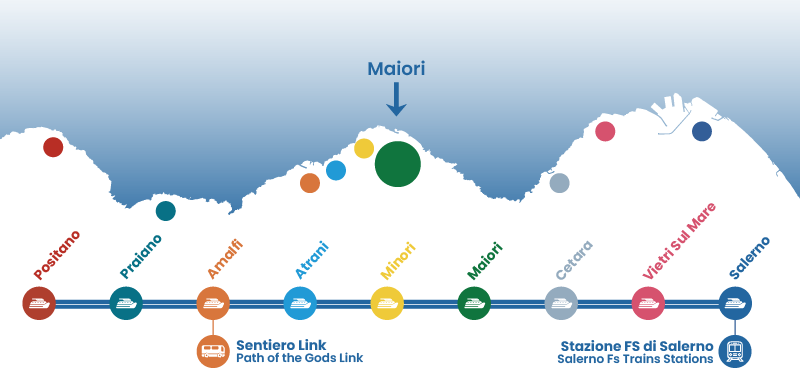Maiori
A peaceful oasis between sea and nature, famous for having the longest beach on the Amalfi Coast.
Maiori, the city of cinema
The beautiful town of Maiori is located in the heart of the Amalfi Coast, just 5 km from Amalfi. It was founded during the Roman era, although the exact date when the first inhabitants, likely of Etruscan origin, settled there is unknown. The town was originally named Reghinna Major (to distinguish it from nearby Reghinna Minor, now Minori), a name used until the 10th century. Like other towns on the Amalfi Coast, Maiori joined the Confederation of Amalfitan States in 842, which was part of the Maritime Republic of Amalfi. It became a key location, hosting the Arsenals, the Admiralty, the Customs House and the Salt Warehouse, and it was known for its fishing, agriculture, and paper industry.

Unlike the vast majority of the other towns of the Amalfi Coast, Maiori boasts a long beach of nearly 1 km, the longest of the entire Amalfi Coast. Here, you will find the oldest seaside establishment on the Divine Coast, which opened in 1945 and quickly became a popular spot for notable guests such as Ingrid Bergman, Jaqueline Kennedy, Fausto Coppi, Totò, Nino Taranto and Anna Magnani, during her romance with director Roberto Rossellini. Rossellini, deeply in love with the place, chose Maiori as the setting for his 1946 masterpiece "Paisà," a seminal work of Italian Neorealism. He returned multiple times to film other important works, inspired by his pilgrimages to the Amalfi Coast.
What to see and what to do in Maiori?
\1
The Castle of San Nicola de Thoro Plano, the Miramare Castle and the Mezzacapo Palace
The Castle of San Nicola de Thoro Plano, an ancient bastion from the 9th century, is a testament to the defensive system of Amalfi. The Miramare Castle, perched on the cliff edge right on the boarder between Maiori and Minori, is distinguished by its towers with conical spires. Palazzo Mezzacapo, with its 18th-century gardens laid out in a Maltese Cross design, was built in the early 19th century and belonged to the Mezzacapo marquises. Today, it houses the municipal library, the historical archive, a cultural laboratory, and several municipal offices.
\2
The Collegiata of Santa Maria a Mare, Sanctuary of the Avvocata and the churches
The Collegiata of Santa Maria a Mare, known for its distinctive majolica-tiled dome, and the evocative Sanctuary of the Avvocata, perched high on Mount Falesio overlooking the entire Amalfi Coast, are must-see landmarks. The sanctuary is accessible only after a lengthy hike, and was built following an apparition of the Virgin to a local shepherd.
Both buildings, along with many other churches in the area, are testimonies to the deep religiosity of the town. Also worth visiting are the Church of Santa Maria del Carmine, next to the Collegiata of Santa Maria a Mare, the Church of San Giacomo, the Church of San Sebastiano and the Church of San Francesco with its adjoining convent.
\3
The Abbey of Santa Maria dell'Olearia
Founded in 973 by the first Benedictine monks in the Amalfi Coast, the Santa Maria dell’Olearia complex was built upon an ancient rock settlement. This historic site offers breathtaking views of the sea and coastline. The complex consists of three small, stacked churches adorned with numerous frescoes dedicated to the Virgin Mary and Saint Nicholas. It stands as a valuable testament to early medieval art and architecture.
\4
Path of the lemons
For trekking lovers, a must-do is the "Path of Lemons" hike. This beautiful trail takes about an hour to traverse from Maiori to Minori, offering breathtaking views and an immersive experience in the distinctive aroma of the numerous lemon groves that adorn this stunning coastline.
\5
Capo d'Orso, the caves and the beaches
Some other suggestions for things to see: the Capo d'Orso promontory, named for its resemblance to a bear's head; Pandora’s caves and the sulfur cave; and the many beautiful beaches, some of which can only be reached by sea. Among them, don’t miss Cala Bellavaia, better known as spiaggia del Cavallo morto (Dead Horse Beach), named after a horse that accidentally fell there while traveling along a mule track.




